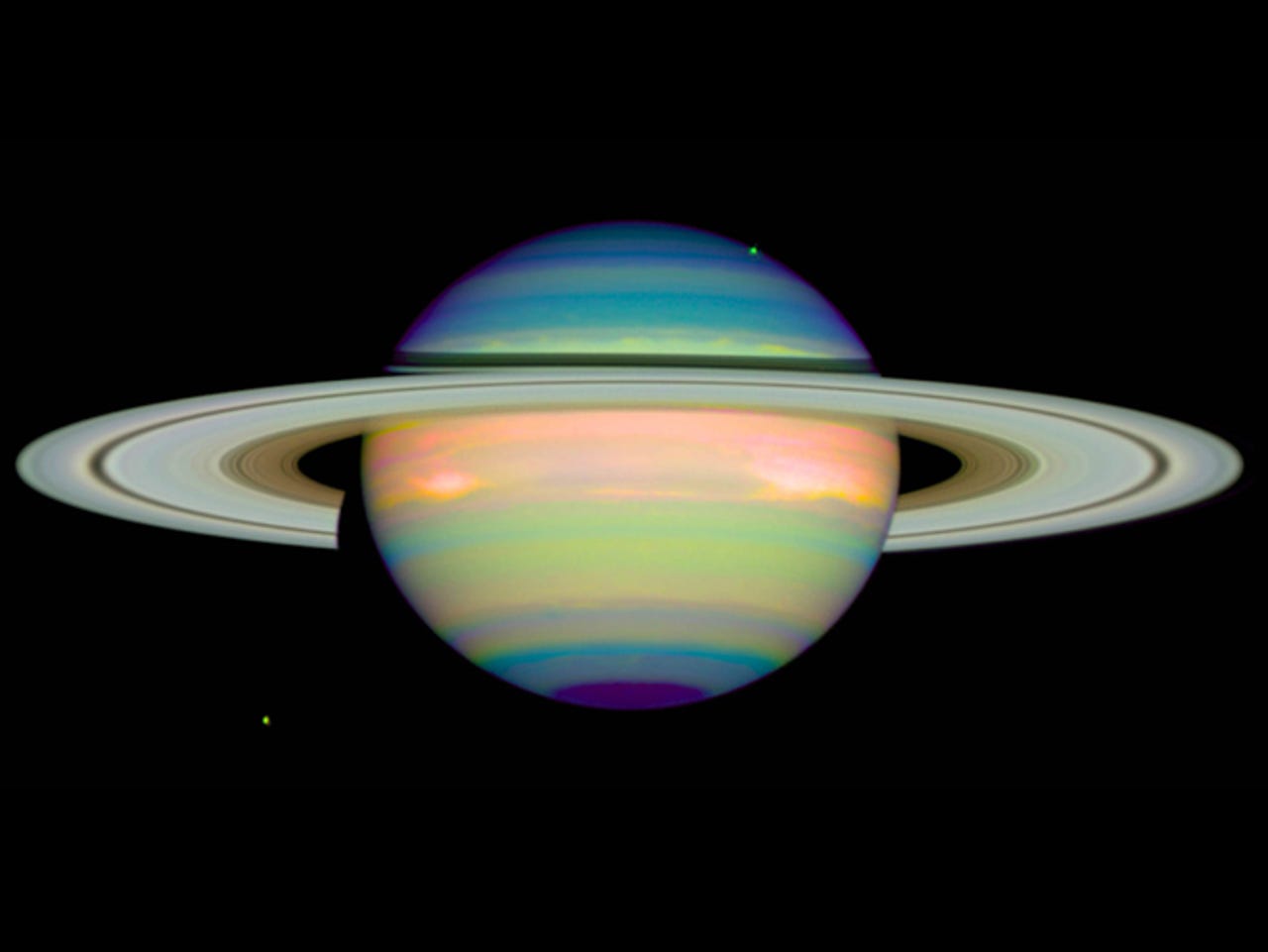Heavenly bodies: Out of this world happenings in 2012


Take a tour around the skies and look out for these celestial happenings throughout 2012. Some of these can be seen by the naked eye, or binoculars. Optics Geeks might like to get themselves a telescope to see distant objects more clearly.
In April, Saturn will be in opposition. Saturn, the gas giant is the sixth planet from the sun and the second largest planet in the solar system after Jupiter.
This is the only planet in our solar system with a clearly detectable set of nine rings. These rings consist of ice particles and rocky debris and reflect the sunlight. There are also moons and hundreds of 'moonlets' orbiting the planet.
Credit: NASA
The Lyrids meteor shower is located in the constellation of Lyra with an average of around 10 meteors per hour. Lyrid fireballs can cast shadows for a split second, then leave behind smoky debris which lasts for a few minutes. Look close to Vega after midnight.
Credit: NASA
The Eta Aqarids appear in the constellation Aquarius and are thought to be associated with Halley's comet. At its peak you might see one meteor per minute, best viewed in dark skies when the moon is new, pre-dawn.
Credit: NASA
Solar eclipses occur when the Moon passes between the Sun and the Earth. They are not rare, typically occurring in some form twice per year. This is the path of the June annular eclipse where part of the Sun will be obscured. It starts in southern China and move east through Japan, the northern Pacific Ocean and the western part of the United States.
Credit: NASA
Lunar eclipses occur when the Earth passes between the Sun and the Moon, obscuring the Sun's rays from hitting the Moon. A portion of the Moon will enter the full shadow (Umbra) giving rise to the partial Lunar eclipse
The eclipse will be visible for a few hours and will be visible throughout most of Asia, Australia, the Pacific Ocean and the Americas.
Credit: NASA
The transit of Venus occurs when the planet passes directly between the Sun and the Earth, obscuring a small portion of the solar disk. It will be visible throughout most of eastern Asia, eastern Australia and Alaska.
A partial transit can be seen at sunrise throughout Europe, western Asia and eastern Africa. A partial transit can be seen in progress at sunset throughout most of North America, Central America and western South America
This is an extremely rare event. The last transit occurred on 8th June 2004 and the next two transits will happen in December 2117 and December 2125.
Credit: NASA
Map showing the areas where the transit of Venus can be seen.
Credit: NASA
The summer solstice occurs when the axial tilt of the Earth's northern hemisphere is most aligned with that of the Sun. The precise time when this will happen in summer 2012 will be UTC 23:09.
Credit: NASA
The Southern Delta Aquariids peak on July 28th and 29th producing about 20 meteors per hour at their peak. Meteors in this region can be seen from July 18 - August 18. This year promises to be a good show as the first quarter Moon will set just after midnight leaving dark skies to see the show. Look east after midnight.
Credit: Meteor Showers Online
Curiosity, the Mars Science Laboratory (MSL) was launched from Cape Canaveral on November 26th 2011. It is scheduled to land on Mars at Gale Crater near Mouint Sharp between August 6th and August 20th 2012. This Mars rover will carry more instruments and experiments than previous rovers. The red Martian landscape will be photographed by Curiosity's high definition camera.
It will be scooping up soil, drilling rocks and trying to determine whether Mars is, or ever has been able to support life.
Credit: NASA
The Perseids are a meteor shower which peaks in activity between August 9th and August 14. You will be able to see some meteor activity from July 23rd to August 22nd. At peak, there will be about 60 meteors or more. They are primarily visible in the northern hemisphere and best seen in the pre-dawn hours.
To find them look north east in the constellation Perseus.
Credit: NASA
Sky map showing where to look to see the Perseid meteor shower occurring around August 13th and 14th
Credit: NASA
Neptune is the eighth and the farthest planet from the Sun. It is the fourth largest planet and, like Neptune, is classed as an ice giant. This blue planet will be closest to Earth and its face will be fully illuminated by the Sun.
Due to its distance it will appear as a tiny blue dot unless you have a very powerful telescope.
Credit: NASA
Uranus is the seventh planet from the Sun. It is the third largest in size and visible to the naked eye. This blue-green ice giant will be at its closest approach to the Earth and its face will be fully illuminated by the Sun.
It has a ring system and numerous moons. The axis of rotation is different to every other planet in the solar system. It is tilted almost horizontally, so its poles are aligned along where the equator would be on most other planets.
Due to its distance it will appear as a tiny blue-green dot unless you have a very powerful telescope.
Credit: NASA
The Orionids meteor shower is the most prolific meteor shower associated with Halley's Comet. The shower produces around 20 meteors per hour at its peak. Best viewing will be to the east after midnight, away from city lights. Look in the constellation of Orion to find the shower.
Credit: NASA
The Moon passes between the Sun and the Earth on November 13th, totally blocking out the whole disk for a number of seconds. The path of totality will only be visible in parts of extreme northern Australia and the southern Pacific Ocean. A partial eclipse will be visible in most parts of eastern Australia and New Zealand.
Credit: NASA
Map showing the part of the total solar eclipse of November 13th
The Leonids appear in the constellation of Leo and produce about 40 meteors per hour at their peak on November 17th and 18th. This year there will be dark skies promising a good show. The best time to watch is after midnight. The Leonids are best known for having bright 'fireballs' which punch into the atmosphere with 'the kinetic energy of a car hitting at 60mph'
Credit: NASA
Look to the east around sunrise on November 27th and you will see Venus and Saturn passing really close to each other. Their separation will be about one degree. Stretch your arm out in front of you. The planets will appear about a fingers width apart and will be very bright.
Credit: NASA
Jupiter is the largest planet in our solar system. It is the fifth planet from the Sun and a gas giant. It is the third brightest object in the sky after the Moon and Venus.
It will be at its closest approach to the Earth and its face will be fully illuminated by the Sun. You will be able to see some of Jupiters moons with a pair of binoculars and even with the naked eye in dark areas.
Credit: NASA
The Geminids are one of the major meteor showers not originating from a comet but from a Palladian asteroid. These meteors are slow moving, multicoloured and show up to 60 meteors per hour at their peak. The shower can be seen from the constellation Gemini.
In 2012 the new Moon will guarantee that there will be dark skies for the show. Look east after midnight.
Credit: NASA
Sky map showing where to look for the Geminids meteor shower on December 13th and 14th